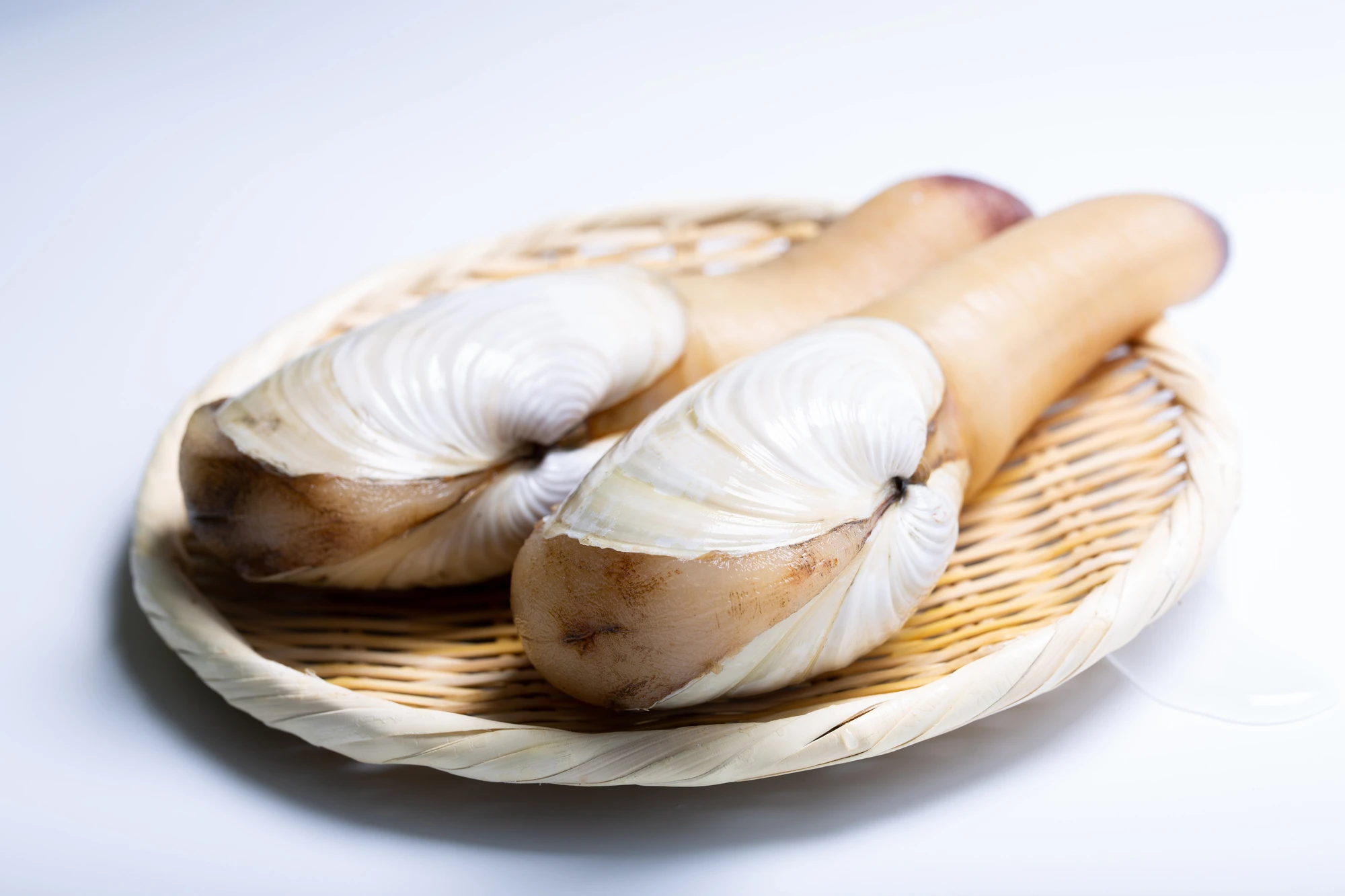MIRUGAI - LIVE FARMED GEODUCK in SHELL - Panopea generosa
Live Shellfish (生貝) (Abalone, Geoduck, Barnacles, etc.)
West Coast Selection (西海岸の選択) (Local, Pacific NW, and imported items available in Vancouver)

Description
海松貝 MIRUGAI - LIVE FARMED LOCAL GEODUCK - Panopea generosa
aka. 巨大二枚貝 Kyodai Nimaigai (Giant BiValve)
Location
Washington
Size/Weight/Grade
#1
> 1.45 lb
Generally white, some coloration around the top of the neck or shell is acceptable.
#1S
1.25 - 1.45 lb
Same grading as #1 but smaller
#2
1.05 - 1.25 lb
Same grading as #1 & 1S at a smaller size
OR
Same size range as 1-1S but with some rust mottling on the skin
#3
1.05 - 0.8 lb
Same grading as #1, #1S & #2 at a smaller size
#3S
0.55 - 0.8 lb
Same grading as #1, #1S, #2 & #3 at a smaller size
#3D
Same size but with a dark shell & siphon, heavy rust mottling on the skin.
Texture/Flavor Profile
Farmed Mirugai offers a sweet, briny flavor with a firm, crisp texture. The meat is dense, slightly chewy, and delicately sweet, with a clean ocean taste that intensifies when served raw. Its natural freshness pairs wonderfully with minimal seasoning to highlight its distinct taste.
Availability/Seasonality
Farmed Mirugai is available year-round, providing a consistent supply of premium geoduck. While wild varieties are seasonal, farmed geoducks are a reliable choice, ensuring chefs can offer this unique delicacy any time of the year. It’s particularly sought after during the cooler months for its exceptional freshness.
About
Panopea generosa, commonly known as the geoduck, is a large clam native to the Pacific coast of North America. The farmed version is cultivated under controlled conditions, ensuring a consistent, high-quality product. The tender, succulent meat of the geoduck contrasts with its firm, crunchy texture, making it a prized ingredient in Japanese cuisine, often featured in sushi and sashimi.
Preparation
To prepare, rinse the geoduck gently and slice it thinly for sushi or sashimi. It can also be lightly seared or grilled, but overcooking should be avoided to maintain its delicate texture. Keep it cold until serving and handle it with care to preserve its fresh, crunchy texture and mild, briny flavor.
Nutritional Value
Mirugai is an excellent source of protein, vitamins, and minerals, including Omega-3 fatty acids. It’s low in fat and high in nutrients, offering a heart-healthy addition to any meal. Its light flavor makes it suitable for a variety of dietary preferences.
Selection and Storage
Choose geoducks with firm, undamaged shells and clear, clean meat. Store them in the coldest part of the refrigerator and consume within 24-48 hours for optimal flavor and texture. If storing longer, freezing is an option, but the meat should be handled gently.
Summary
Live farmed Mirugai offers a sweet, clean ocean flavor with a firm texture, perfect for sushi, sashimi, or light cooking. Its availability year-round makes it a reliable choice for chefs seeking high-quality, fresh geoduck, providing a unique culinary experience in any dish.
aka. 巨大二枚貝 Kyodai Nimaigai (Giant BiValve)
Location
Washington
Size/Weight/Grade
#1
> 1.45 lb
Generally white, some coloration around the top of the neck or shell is acceptable.
#1S
1.25 - 1.45 lb
Same grading as #1 but smaller
#2
1.05 - 1.25 lb
Same grading as #1 & 1S at a smaller size
OR
Same size range as 1-1S but with some rust mottling on the skin
#3
1.05 - 0.8 lb
Same grading as #1, #1S & #2 at a smaller size
#3S
0.55 - 0.8 lb
Same grading as #1, #1S, #2 & #3 at a smaller size
#3D
Same size but with a dark shell & siphon, heavy rust mottling on the skin.
Texture/Flavor Profile
Farmed Mirugai offers a sweet, briny flavor with a firm, crisp texture. The meat is dense, slightly chewy, and delicately sweet, with a clean ocean taste that intensifies when served raw. Its natural freshness pairs wonderfully with minimal seasoning to highlight its distinct taste.
Availability/Seasonality
Farmed Mirugai is available year-round, providing a consistent supply of premium geoduck. While wild varieties are seasonal, farmed geoducks are a reliable choice, ensuring chefs can offer this unique delicacy any time of the year. It’s particularly sought after during the cooler months for its exceptional freshness.
About
Panopea generosa, commonly known as the geoduck, is a large clam native to the Pacific coast of North America. The farmed version is cultivated under controlled conditions, ensuring a consistent, high-quality product. The tender, succulent meat of the geoduck contrasts with its firm, crunchy texture, making it a prized ingredient in Japanese cuisine, often featured in sushi and sashimi.
Preparation
To prepare, rinse the geoduck gently and slice it thinly for sushi or sashimi. It can also be lightly seared or grilled, but overcooking should be avoided to maintain its delicate texture. Keep it cold until serving and handle it with care to preserve its fresh, crunchy texture and mild, briny flavor.
Nutritional Value
Mirugai is an excellent source of protein, vitamins, and minerals, including Omega-3 fatty acids. It’s low in fat and high in nutrients, offering a heart-healthy addition to any meal. Its light flavor makes it suitable for a variety of dietary preferences.
Selection and Storage
Choose geoducks with firm, undamaged shells and clear, clean meat. Store them in the coldest part of the refrigerator and consume within 24-48 hours for optimal flavor and texture. If storing longer, freezing is an option, but the meat should be handled gently.
Summary
Live farmed Mirugai offers a sweet, clean ocean flavor with a firm texture, perfect for sushi, sashimi, or light cooking. Its availability year-round makes it a reliable choice for chefs seeking high-quality, fresh geoduck, providing a unique culinary experience in any dish.







